Energy - Geothermal
Thought of as sacred, with healing properties provided by divinities, hot springs gathers those near and far to bask in the warmth of its waters. Eons ago, our predecessors used these places for gatherings and rituals. Today, while we still utilize hot springs for the same reasons, we found another use for it, namely, the generation of electricity.
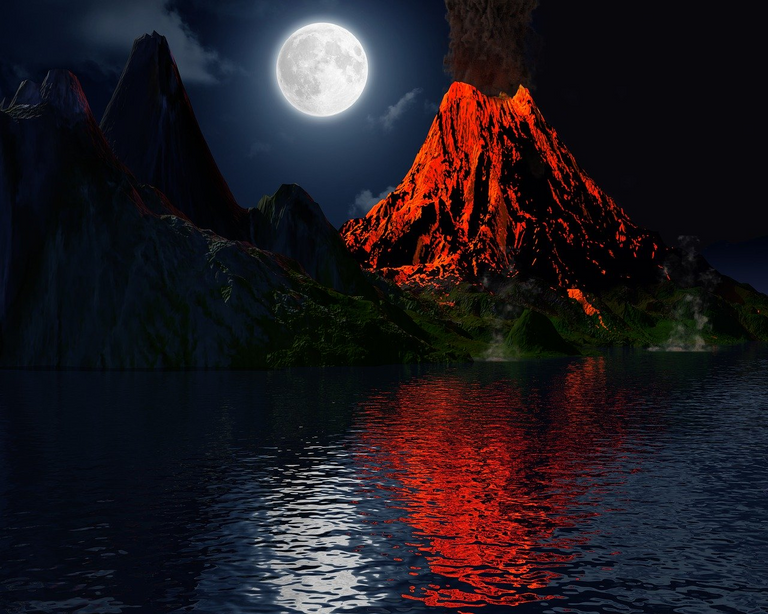
Image by Alexander Antropov from Pixabay
Prologue
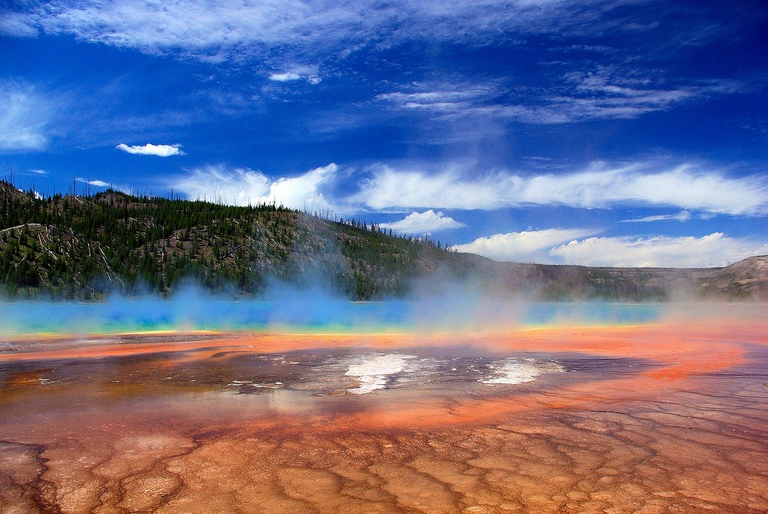
Image by Mike Goad from Pixabay
A need for geothermal
The impact we have on the Earth will only become more significant over time. Our journey towards becoming a more advanced civilization finds us consuming more and more electricity. The awareness we have of our impact must grow to match our need for power; Otherwise, we run the risk of damaging our planet beyond repair.
We must balance our energy portfolio and utilize as much of the planet's energy as efficiently as possible. Herein lies a reason for harnessing the power of geothermal energy. Using the power of the Earth significantly reduces our greenhouse gas footprint.
Brief history of geothermal
History credits Prince Piero Ginori Conti with the creation of the first geothermal power plant in Tuscany, Italy, in 1904 (Energy.gov). The power produced by this facility pales in comparison to today's output, but that isn't the point. The point is that we created a process to convert the Earth's energy into electricity consistently.
Prince Conti's first power plant produced only enough energy to first turn on some light bulbs. Today, the Geysers GeoThermal powerplant in California provides a combined max output of 1.5 gigawatts of power.
Introduction

Image by Robert Fotograf from Pixabay
Welcome, fellow Steemians, to our seventh installment in the Energy series. In this post, we will discuss geothermal power and its basics, the effect upon the environment, and much more! We did not address the topic of geothermal energy in our first installment (Energy - Overview).
In our Energy series, we discussed how various forms of power production ultimately produce electricity. Coal, nuclear, concentrating solar, hydroelectric, and wind power plants product electricity similarly albeit with different sources of fuel. Geothermal power is not too different except that here, the power of the Earth is the driving source of power production.
Geothermal Power Generation
Basics of Geothermal
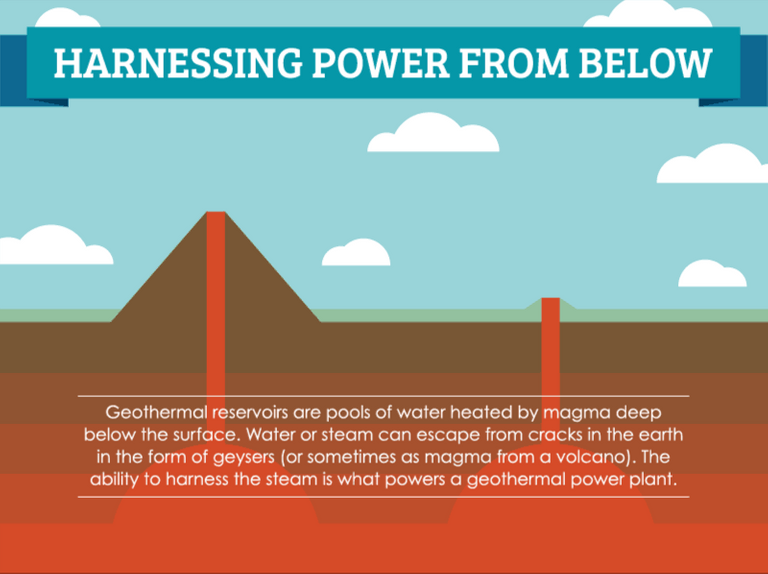
SaveOnEnergy
Overview
The production of electricity from geothermal power starts with the use of geothermal reservoirs. These reservoirs are nothing more than pools of water heated by magma within the Earth. We build technology to draw that water out to use in our production cycle.
Coal power plants must burn pulverized coal to produce water hot enough to turn into steam. The magma near geothermal reservoirs provides water at a sufficient enough temperature that we do not need to burn fuel like coal or Uranium to produce steam-driven electricity. In other words, we don't need human-made technologies to heat the water initially.
We take the water within the geothermal reservoir and either convert it to steam or use the steam already produced.
The technologies direct the steam produced against the blades of the turbine and causes it to rotate. The turbine, through its rotation, converts the kinetic energy of the wind into electrical energy produced by a generator that spins with the turbine.
Video Summary
Power Plant Demographics
Power Plant Types
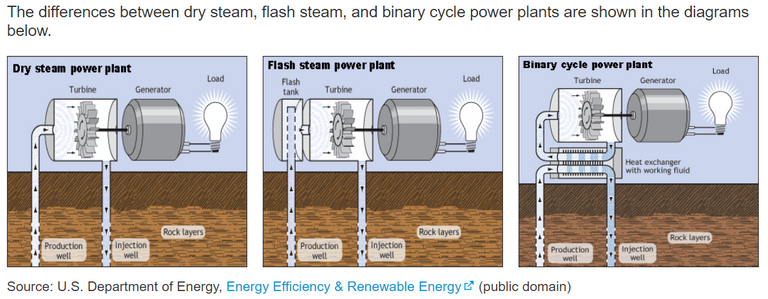
Energy Information Administration (EIA)
Geothermal energy employs three different types of power plants to convert water from a reservoir into an electrical output. In general geothermal power plants draw in water or steam from an injection well created for the plant.
If the injection well only contains steam, then it has any moisture and pollutants removed before transfer to the turbine for electricity generation. If the injection well as high-pressure and high-temperature water, then that water is converted to steam, treated, and dried before directing it to the turbine.
Steam already used for turbine rotation loses its heat and condenses into water. The system redirects that condensed water into an injection well that pumps it back into a geothermal reservoir for reheating by the nearby magma.
A significant contribution towards variations in Geothermal technology is during the process of extracting steam or water from deep beneath the Earth.
Dry Steam
Dry Steam geothermal power plants utilize steam, already coming from the ground, for use in creating electricity, as we discussed in our overview (EIA).
Flash Steam
Flash steam plants draw in high-pressure and high-temperature water from a production well and flash it into steam. It also further treats the generated steam, if needed, before being sent into the turbine (EIA).
Binary Cycle
Binary cycle power plants take high-pressure and high-temperature water from a production well and pass it through a heat exchanger. Inside the heat exchanger, it transfers its heat to a passing liquid like water.
The liquid is converted to steam and is then used to rotate the turbine-generator and produce electricity. When the fluid exits the turbine, it passes through an injection well and back into a reservoir for reheating (EIA).
Geothermal reservoirs
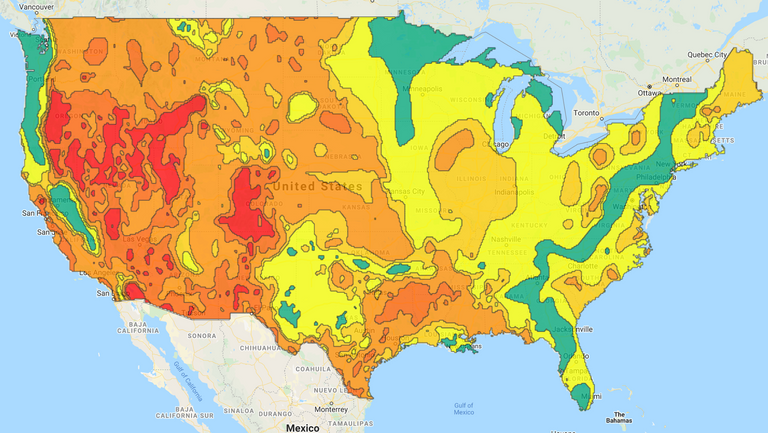
Energy101 - National Renewable Energy Laboratory (NREL)
The best geothermal reservoirs are those already at a temperature and pressure high enough for use in the production cycle. What this means is that you wouldn't have to direct additional resources to convert water into steam before sending it onward to the turbine-generator.
The map above shows the United States with a multi-colored overlay. It represents the geothermal potential of the U.S. (NREL) with colors varying from green (low potential) to red (high potential). Potential, in this case, likely means that the geothermal energy is sufficient enough to allow for power production for the least cost.
Building a power plant in the red areas indicated ensures that the power plant may utilize fewer resources to produce reliable and continuous electricity through geothermal energy.
Capacity/Locations
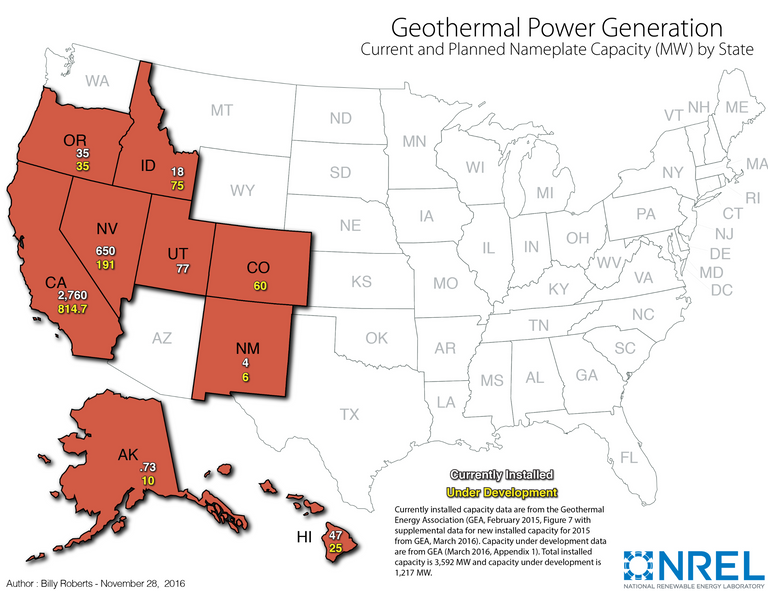
Energy101 - National Renewable Energy Laboratory (NREL)
The map provided above is as recent as 2016. The industry finds that the western part of the United States contains the majority of useable commercial geothermal resources.
Geothermal Advantages

Image by Niek Verlaan from Pixabay
Clean Energy Source
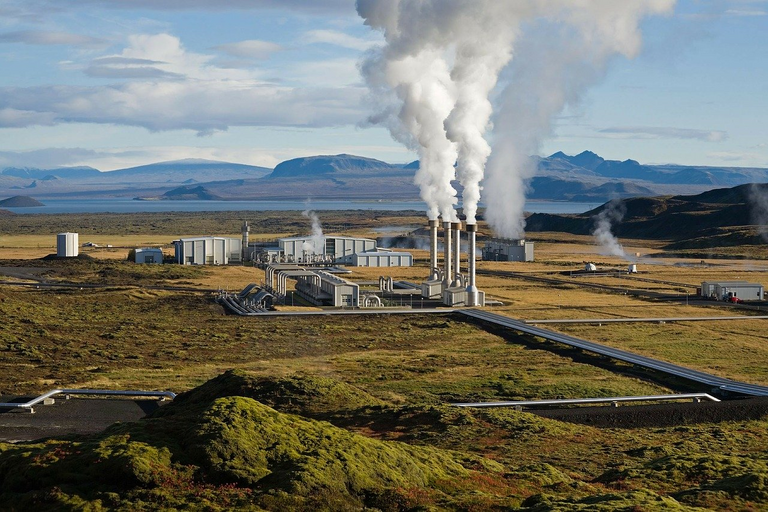
Image by WikiImages from Pixabay
The water available in geothermal reservoirs are mostly ready for use in the power plant without burning dirty fuels like coal or radioactive fuels like UraniumUranium. You don't need to build an intricate and costly facility like a nuclear power plant or furnace to heat the water.
While the power plant can release airborne pollutants, it is on a far lesser scale than the more common forms of power. Additionally, the heat produced is constant, so long as we don't abuse it. What this means is that the power is on hand and available all year long.
Environmental Impact-Wildlife
Any development of human-made technologies in the environment will have some impact. Depending on the area anticipated for geothermal, surrounding wildlife behaviors will be affected.
The Geothermal Energy industry is aware of this, however, and has guidelines for mitigating the effects of power production on the animal population. Additionally, some information sites maintain a detailed listing of habitats disturbed by the existence of geothermal power plants (OpenEI). Information like this is not as readily available for nuclear, coal, solar, or even wind power plants.
Geothermal Disadvantages

Image by Oberholster Venita from Pixabay
Release of greenhouse gases
The removal of geothermal energy leads to the release of greenhouse gases like hydrogen sulfide, carbon dioxide, and ammonia albeit on a smaller scale than the significant producers of power (GreenMatch). Despite the low volume of release, these gases are deadly to humans and the environment. Power plants must exercise adequate caution to ensure we mitigate releasing these gases outside of a controlled environment.
In the case of geothermal, improper management of sulfur dioxide releases could lead to the production of acid rain in localized areas (Union of Concerned Scientists).
However, this is more of a remnant of poor industrial practices commonplace in our past. Should this occur nowadays, it would most likely be the result of equipment failure or human negligence. I have not discovered anything of recent note regarding the use of geothermal power and acid rain production.
Location Specific
Reliable locations for the development of power plants is limited. It's sad in a way because the technology is very effective at producing clean energy.
Here is a more precise dilemma on problems with geothermal power locations:
- On the one hand, coal is so abundant, with a presence so commonplace that you can transport thousands of tons of coal per day to almost any coal plant in the United States.
- On the other hand, you have geothermal reservoirs so limited that, concerning the U.S., that we can only build power plants on one side of the country.
Earthquakes
If you inject water into rocks and sediment deep within the Earth, you are going to cause earthquakes (Scientific American).
You will not avoid one.
Areas not commonly prone to earthquakes will eventually suffer through one so long as any geothermal drilling occurs. California, a U.S. state near many sources of geothermal reservoirs, once even recorded an earthquake as high as 4.5 due to drilling (Scientific American). The state is prone to about 4000 earthquakes per year.
"Sustainable and Renewable"
One bitter taste I get is for terms like "sustainable and renewable" when they are applied, as a means of advertising, towards renewable energy sources.
One problem within the realm of geothermal is the rate of heat removal within a reservoir. We need to have an intricate understanding of the amount of energy we can remove. If we pull too much heat out of the well, without considering how it impacts the process, you run the risk of shutting down the reservoir. Power plants need to ensure they only pull what is possible.
Energy from geothermal is renewable and sustainable so long as we abide by what the reservoir produces in terms of heat and resources from the ground.
Technology Summary
Geothermal power is clean and renewable with certain limitations. The technology needed for the production of electricity is relatively safe and reliable. The environmental impact of this type of generation is minimal, and the industry appears to be actively engaged in minimizing the disturbance of the ecosystem it inhabits.
In Closing

Thanks again, fellow Steemians, for following on with this series. Our next article will be on Biomass Power Production and covers similar topics as coal, nuclear, solar, hydro, and wind.
Each topic presented poses different challenges during research. It is essential to cite all available references for this work to ensure that all readers can validate the information presented as they desire. The goal, ultimately, is the dissemination of accurate and thoughtful information. Unfortunately, some topics are more difficult to research than others.





Looking to nature to overcome problems presenting themselves with scarcity in electricity is a good start.
If properly executed without creating an imbalance in nature, nor overusing as we have historically done with coal. All new ideas are good until tested and proven with positive results.
@tipu curate
Upvoted 👌 (Mana: 0/4 - need recharge?)
@joanstewart
Thank you for your response. I agree with your thoughts regarding new ideas and testing. Ideas can't survive without them. Hopefully, our future endeavors with power production learn to be intricately involved with its impact upon the environment. It appears as if we only try to stem any adverse effects one we implement the technology.
Always something interesting happening, I remember forty years ago people talking about capturing a lightning bolt and "bottling", crazy concept, who knows perhaps one day we will find something from nature, cleaner not what we currently rely on.
@joanstewart
We will undoubtedly find something cleaner that what we rely on at this time. I do not doubt that belief. I haven't seen an energy production technology yet that has moved backward concerning being clean, minimizing its impact, and raising its output.
People are relying more and more on energy we have to find ways not to leave a negative imprint on the ecosystem.